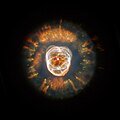Stars
The constellation contains 85 stars of naked eye visibility. [6] [7]
The brightest star in Gemini is Pollux, and the second-brightest is Castor. Castor's Bayer designation as "Alpha" arose because Johann Bayer did not carefully distinguish which of the two was the brighter when he assigned his eponymous designations in 1603. Although the characters of myth are twins, the actual stars are physically very different from each other.
α Gem (Castor) is a sextuple star system 52 light-years from Earth, which appears as a magnitude 1.6 blue-white star to the unaided eye. Two spectroscopic binaries are visible at magnitudes 1.9 and 3.0 with a period of 470 years. A wide-set red dwarf star is also a part of the system; this star is an Algol-type eclipsing binary star with a period of 19.5 hours; its minimum magnitude is 9.8 and its maximum magnitude is 9.3.
β Gem (Pollux) is an orange-hued giant star of magnitude 1.14, 34 light-years from Earth. Pollux has an extrasolar planet revolving around it, as do two other stars in Gemini, HD 50554, and HD 59686.
γ Gem (Alhena) is a blue-white hued star of magnitude 1.9, 105 light-years from Earth.
δ Gem (Wasat) is a long-period binary star 59 light-years from Earth. The primary is a white star of magnitude 3.5, and the secondary is an orange dwarf star of magnitude 8.2. The period is over 1000 years; it is divisible in medium amateur telescopes.
ε Gem (Mebsuta), a double star, includes a primary yellow supergiant of magnitude 3.1, nine hundred light-years from Earth. The optical companion, of magnitude 9.6, is visible in binoculars and small telescopes.
ζ Gem (Mekbuda) is a double star, whose primary is a Cepheid variable star with a period of 10.2 days; its minimum magnitude is 4.2 and its maximum magnitude is 3.6. It is a yellow supergiant, 1,200 light-years from Earth, with a radius that is 60 times solar, making it approximately 220,000 times the size of the Sun. The companion, a magnitude 7.6 star, is visible in binoculars and small amateur telescopes.
η Gem (Propus) is a binary star with a variable component. 380 light-years away, it has a period of 500 years and is only divisible in large amateur telescopes. The primary is a semi-regular red giant with a period of 233 days; its minimum magnitude is 3.9 and its maximum magnitude is 3.1. The secondary is of magnitude 6.
κ Gem is a binary star 143 light-years from Earth. The primary is a yellow giant of magnitude 3.6; the secondary is of magnitude 8. The two are only divisible in larger amateur instruments because of the discrepancy in brightness.
μ Gem (Tejat) is a red giant 230 light-years from Earth, about a hundred times larger than the Sun.
ν Gem is a double star divisible in binoculars and small amateur telescopes. The primary is a blue giant of magnitude 4.1, 550 light-years from Earth, and the secondary is of magnitude 8.
38 Gem, a binary star, is also divisible in small amateur telescopes, 84 light-years from Earth. The primary is a white star of magnitude 4.8 and the secondary is a yellow star of magnitude 7.8.
U Gem is a dwarf nova type cataclysmic variable discovered by J. R. Hind in 1855. [9]
Deep-sky objects
M35 (NGC 2168) is a large, elongated open cluster of magnitude 5, discovered in the year 1745 by Swiss astronomer Philippe Loys de Chéseaux. It has an area of approximately 0.2 square degrees, the same size as the full moon. Its high magnitude means that M35 is visible to the unaided eye under dark skies; under brighter skies it is discernible in binoculars. The 200 stars of M35 are arranged in chains that curve throughout the cluster; it is 2800 light-years from Earth. Another open cluster in Gemini is NGC 2158. Visible in large amateur telescopes and very rich, it is more than 12,000 light-years from Earth.
NGC 2392 is a planetary nebula with an overall magnitude of 9.2, located 4,000 light-years from Earth. In a small amateur telescope, its 10th magnitude central star is visible, along with its blue-green elliptical disk. It is said to resemble the head of a person wearing a parka.
The Medusa Nebula is another planetary nebula, some 1,500 light-years distant. Geminga is a neutron star approximately 550 light-years from Earth. Other objects include NGC 2129, NGC 2158, NGC 2266, NGC 2331 and NGC 2355.

![]() (♊︎).
(♊︎).








